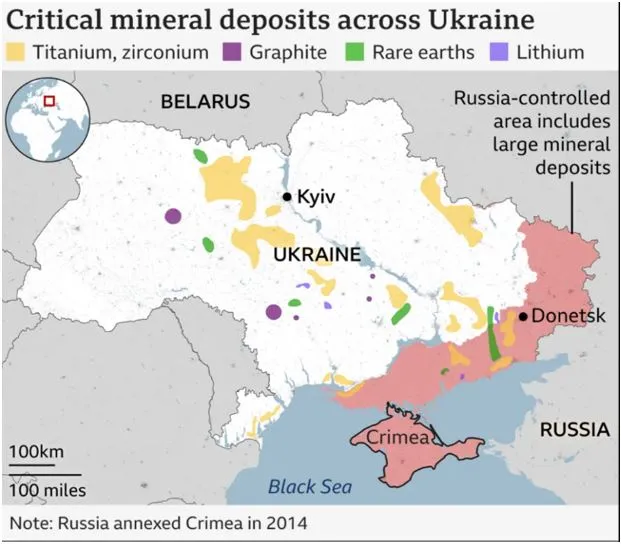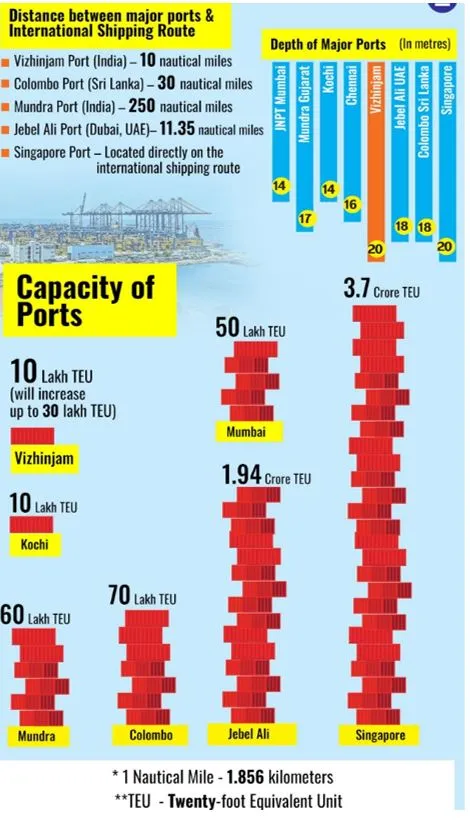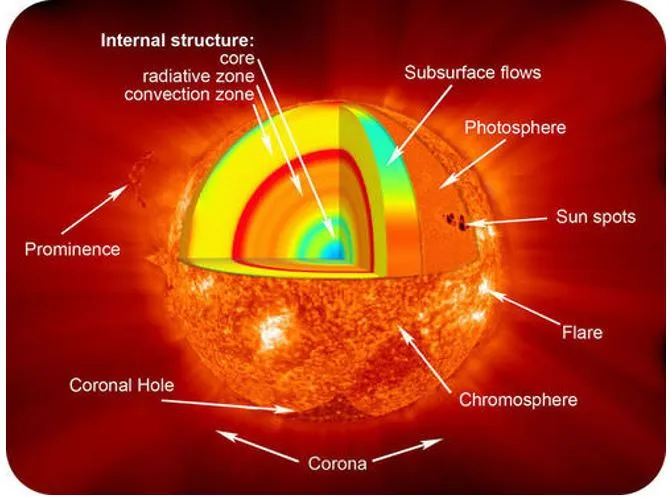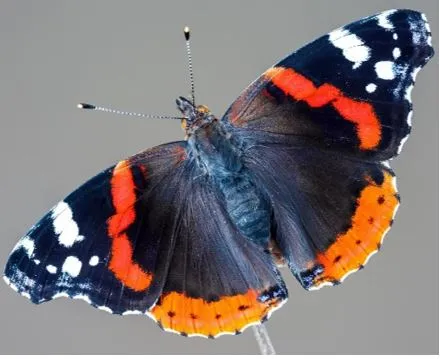

2nd May 2025 (10 Topics)
Mains Issues
Context
The United States and Ukraine signed a landmark deal—called the US-Ukraine Reconstruction Investment Fund. This agreement gives Washington access to Ukraine’s rich reserves of critical minerals, and in return, helps fund Ukraine’s reconstruction and military support.
What exactly is this deal about?
- The agreement creates a joint investment fund between the US and Ukraine. This fund will help support Ukraine’s post-war economic recovery.
- In return, the US will get partial access and shared profits from future sales of Ukraine’s critical minerals like lithium, titanium, graphite, and rare earth elements.
- The partnership is based on a 50:50 revenue-sharing model.
- Ownership of Ukraine’s mineral resources remains with Ukraine, and the country retains the right to decide what and where to extract.
- Ukraine is not obligated to repay past US aid under this agreement.
- The deal also includes new US military assistance (e.g., air defense systems), although no formal security guarantees were offered.

What are ‘critical minerals’ and why are they important?
- Rare earths are a group of 17 metals used to make magnets that turn power into motion for electric vehicles, cell phones, missile systems, and other electronics. There are no viable substitutes.
- Critical minerals are naturally occurring elements that are essential to modern industries, especially in:
- Green energy: Used in electric vehicles (EVs), wind turbines, solar panels, and batteries.
- Defense: Important for missile systems, radar, drones, etc.
- High-tech electronics: Smartphones, laptops, semiconductors.
- Aerospace: Satellites, jet engines.
- The US Geological Survey (USGS) considers around 50 minerals as “critical,” including rare earths, lithium, nickel, cobalt, graphite, and titanium.
- These minerals are difficult to substitute, and their supply chains are concentrated—especially in China, which controls about 90% of global rare-earth production.
What minerals does Ukraine have, and where?
- Ukraine is rich in critical minerals. About 5% of the world's "critical raw materials" are in Ukraine. Ukraine has deposits of 22 of the 34 minerals identified by the European Union as critical:
- Lithium: Estimated 500,000 metric tons, used in batteries; deposits found in central and southeastern regions.
- Graphite: Around 20% of global reserves; key for EVs and nuclear energy.
- Titanium: Used in aerospace and defense; found in the northwest and central regions.
- Rare earth elements: Including neodymium, cerium, lanthanum, and others, essential for electronics and military tech.
- Nickel, cobalt, gallium, zirconium, beryllium, and scandium are also present.
- However, 40% of Ukraine’s mineral reserves (including some lithium and coal) are currently in Russian-occupied territory, making control and development challenging.
Critical Minerals in India
|


Mains Issues
Context
Prime Minister Narendra Modi inaugurated the World Audio Visual and Entertainment Summit (WAVES) 2025 at the Jio World Convention Centre in Mumbai. The event is being seen as a milestone for India’s growing creative economy, often referred to as the “Orange Economy” — a sector that includes music, film, gaming, animation, fashion, digital content, and more.
What is the Orange Economy?
- The Orange Economy (also called the Creative Economy) refers to industries whose products and services are based on creativity, culture, and intellectual property. This includes:
- Film and Television
- Music and Performing Arts
- Gaming and Animation
- Digital Content & OTT Platforms
- Fashion and Design
- Advertising, Publishing, and Cultural Tourism
- The term was popularized by UNESCO and the Inter-American Development Bank (IDB) to describe sectors that generate economic value through cultural expressions and creativity.
- 112 years ago, on May 3, 1913, Raja Harishchandra, widely recognised as India's first full-length feature film directed and produced by Dadasaheb Phalke, was released.
- Government Initiatives: The government has announced a USD 1 billion creative economy fund, and is setting up an Indian Institute of Creative Technology (IICT) in Mumbai to skill the next generation.
- The government has announced a USD 1 billion creative economy fund, and is setting up an Indian Institute of Creative Technology (IICT) in Mumbai to skill the next generation.
- Economic Contributions:
- India's creative economy already contributes USD 30 billion to GDP, employing 8% of the workforce.
- Creative exports exceed USD 11 billion annually, and sectors like YouTube and digital design are enabling small-town creators to reach global audiences.
- It can grow to over USD 100 billion within the next decade.
- Challenges: Weak IP enforcement, limited rural digital access, and lack of formal financing persist
What is WAVES 2025?
- WAVES stands for World Audio Visual and Entertainment Summit. It is a global platform that brings together:
- Artists and Creators
- Technology Companies
- Media Giants
- Investors and Policymakers
- Industry Leaders from over 100 countries
- WAVES 2025 will serve as a major gathering of global storytellers, fostering innovation, creativity, and collaboration in film, series, gaming, and digital entertainment. The event will bring together over 10,000 delegates, 1,000 creators, 300 companies, 350 startups, and leaders from over 90 countries.
- The goal is to position India as a hub for the global creative economy, explore new partnerships, and promote India’s soft power through entertainment, culture, and technology.
Why is there a shift in focus on Orange Economy?
- Demographic Strength: India has one of the youngest populations globally with strong digital skills and creativity.
- Digital Infrastructure: The OTT platforms, mobile gaming, and streaming services are witnessing rapid growth. There is growth of AI-driven content creation and animation studios.
- Global Cultural Impact: Indian cinema, music, and digital creators have growing international audiences.
- Soft Power Strategy: Cultural exports like Bollywood, yoga, and Indian cuisine are part of India's diplomatic and image-building toolkit.
- Policy Push: GOI has rolled out incentives like film shooting subsidies, startup policies, and is promoting India as a global content production destination.


Prelims Articles
Context
The Archaeological Survey of India (ASI) has discovered eleven ancient inscriptions in the Gundaram Reserve Forest near Peddapalli, Telangana. Dating from the 1st century BCE to the 6th century CE, these inscriptions provide new insights into the early history of the Deccan, particularly the Satavahana period.
Key Findings
- Link to Satavahana Dynasty: One of the inscriptions, written in early Brahmi script, records that a person from the H?ritiputra lineage, likely part of the Chu?u dynasty, excavated a cave for Buddhist monks. He describes himself as a friend of Kum?ra Hakusiri, a prince of the Satavahana dynasty.
- Religious Symbolism: Another inscription includes religious symbols such as a trident and a damaru (a small drum associated with Lord Shiva). This is considered the first known instance of such religious iconography being used in early South Indian inscriptions. It may show how political authority was beginning to associate with religious symbolism during that time.
- Additional Names: Other inscriptions mention royal figures like Kum?ra Sakasiri and Akusiri, suggesting that the region was of political importance during the Satavahana period.
- Confirmation of Telangana’s Ancient Role: These discoveries support earlier evidence from other sites, such as Kotilingala, showing that Telangana was historically part of Asmaka—one of the sixteen major states (Mah?janapadas) in ancient India, known from texts dating back to the 6th century BCE.
- Possible Buddhist Monastic Site: Based on the location and nature of the inscriptions, the area may have once served as a burial ground or spiritual retreat for Buddhist monks.
Fact Box: Satavahana Empire
Chutu Dynasty (1-3rd Century CE)
|


Prelims Articles
Context
The Goods and Services Tax (GST) revenue reached a record-breaking Rs 2.37 lakh crore in April, showing a 12.6 per cent year-on-year increase, according to official government statistics.
What is GST?
- The Goods and Services Tax (GST) is an indirect tax which has replaced many indirect taxes in India such as the excise duty, VAT, services tax, etc.
- The Goods and Service Tax Act was passed in the Parliament on 29th March 2017 and came into effect on 1st July 2017.
- The 101st Constitution Amendment Act of 2016introduced the Goods and Services Tax (GST) in India, creating a unified indirect tax system.
- GST is levied on the supply of goods and services. It replaced multiple existing taxes (service tax, duties of excise, cess and surcharge, VAT, entertainment tax, etc.) with a single, streamlined tax, applying to the supply of goods and services.
- Goods and Services Tax Law in India is acomprehensive, multi-stage, destination-based tax that is levied on every value addition.
- After subsuming majority indirect taxes, GST is a single domestic indirect tax law for the entire country.
GST Council
|
PYQQ. What is/are the most likely advantages of implementing ‘Goods and Services Tax (GST)’? (2017)
Select the correct answer using the code given below:
Answer: (a) 1 only Q. Consider the following items: (2018)
Which of the above items is/are exempted under GST (Goods and Services Tax)?
Solution: (c) |


Prelims Articles
Context
Prime Minister Narendra Modi inaugurated the Vizhinjam International Seaport in Kerala. This marks the commissioning of India’s first deepwater transshipment port, aimed at transforming India into a global shipping and logistics hub, reducing dependence on foreign ports, and enhancing maritime self-reliance.
What is the Vizhinjam Port Project?
- Vizhinjam is a container transshipment terminal. It is India's latest international deep-water transshipment facility.
- It is situated in the southern part of Kerala, India, near the state capital, Thiruvananthapuram.
- Type: Deepwater container transshipment port
- Model: Public-Private Partnership (PPP)
- Operatorship:
- Adani Ports & SEZ Ltd (28.9%)
- Kerala Government (61.5%)
- Union Government (9.6%)
- Current Capacity: 1 million TEUs (to expand to 7.4 million in future phases)
- First vessel handled: MSC Türkiye — one of the world’s largest container ships (24,000+ TEUs)
- Transshipment Port: A transshipment port is where containers are transferred from large "mother vessels" to smaller feeder ships for onward delivery to regional destinations.
- These ports are crucial for global shipping efficiency, especially for countries with significant import/export volumes but no large-vessel handling capacity.
- Until now, 75% of India’s transshipment cargo was handled through foreign ports like (It made movement of goods slower and more expensive):
- Colombo (Sri Lanka)
- Singapore
- Jebel Ali (UAE)
Why Vizhinjam is a Game Changer?
- Strategic Location: It is just 10 nautical miles from the busy East-West global shipping route. Vizhinjam’s location connects key global ports like Shanghai, Busan, and Rotterdam with major Indian ports, giving Kerala an edge in global logistics.
- Natural Deep Draft: It is deep enough (20 meters) to accommodate Ultra Large Container Vessels (ULCVs) — without artificial dredging. It saves huge costs and avoids environmental damage
- Low Maintenance: Minimal littoral drift (sand movement) makes it cheaper to maintain than most Indian ports
- Reducing Logistics Costs: India currently loses USD 200–220 million annually by outsourcing transhipment. Domestic exporters pay USD 80–100 extra per container due to foreign port usage

Fact Box: Ports in India
|


Prelims Articles
Context
A team of international scientists, including researchers from India, has discovered giant plasma tides beneath the surface of the Sun.
Key Findings:
- Discovery of Plasma Tides: Massive waves of hot plasma, like ocean tides, have been found in a turbulent region beneath the Sun's surface called the Near-Surface Shear Layer (NSSL).
- These plasma flows occur about 35,000 km below the Sun’s surface.
- The tides are closely linked to the Sun’s 11-year magnetic cycle, which controls sunspots and solar flares.
- The finding challenges older beliefs that solar magnetic fields come from deep within the Sun. They may instead form closer to the surface.
- Better Space Weather Forecasting: Understanding these internal flows could help scientists predict solar storms more accurately and protect Earth’s tech infrastructure.
About Sun
 |


Prelims Articles
Context
For the first time ever in India, the European Red Admiral butterfly (Vanessa atalanta) has been recorded in Himachal Pradesh, specifically in the Dhauladhar mountain range near Dharamshala.
About the European Red Admiral (Vanessa atalanta):
- Scientific Name: Vanessa atalanta
- Family: Nymphalidae (Brush-footed butterflies)
- Type: Migratory butterfly species
- Native Range: Widely found across Europe and North America
- Recent Range Expansion: Also seen in South and Central Asia, with the last confirmed South Asian record in Pakistan (Lower Chitral, 2022) after a 93-year gap.
- Key Characteristics:
- Appearance: It is similar to the Indian Red Admiral (Vanessa indica)
- Key Differences:
- Narrower and deeper crimson discal band
- Prominent white spot in the upper forewing (absent in Indian cousin)
- Habitat & Diet:
- Larval Host Plant: It feeds primarily on stinging nettle (Urtica dioica)
- This plant is common in the Western Himalayas, possibly supporting the butterfly’s presence.
- Altitude Noted in India: It is found at 2,500 meters elevation in Thatharna Hill.



Editorials
Context
Chinese President Xi Jinping’s recent three-nation Southeast Asia visit to Vietnam, Malaysia, and Cambodia comes at a time when China faces 145% tariffs from the U.S. under Trump-era protectionist policies. The visit marks a strategic recalibration of China's foreign policy to counter U.S.-led economic decoupling and reinforce Beijing’s influence in the Indo-Pacific. It also follows the Central Conference on Work Relating to Neighbouring Countries, underscoring the importance of consolidating China’s periphery diplomacy.
Economic Diplomacy as Strategic Counterweight
- Alternative to U.S. Tariffs and Decoupling: Facing punitive U.S. trade actions, China is positioning Southeast Asia as a buffer and bridge to sustain trade routes, diversify manufacturing, and cushion against economic containment efforts.
- High-Level Engagements and Agreements: Xi’s tour led to the signing of 45 MoUs with Vietnam, over 30 agreements with Malaysia, and reaffirmation of $15+ billion trade with Cambodia, showcasing tangible economic cooperation in infrastructure, AI, agriculture, and digital sectors.
- Rebuttal to Protectionism: Xi presented China as an open, multilateral economic partner, in contrast to U.S. unilateralism and tariff hikes on regional countries — 59% for Cambodia, 46% for Vietnam, and 24% for Malaysia.
Ideological Messaging and Soft Power Projection
- Normative Framing Against U.S. Interventionism: China advanced its non-interference doctrine and "community with a shared future" as alternatives to perceived S. ideological rigidity, especially resonant in Cambodia and partially in Malaysia.
- Promotion of BRI and Regional Codes: China emphasized progress on a Code of Conduct in the South China Sea, promotion of BRI projects, and cultural diplomacy to project itself as a regional order-builder and soft power hub.
- Strategic Contrast to U.S. Alliances: While the U.S. leans on security coalitions (Quad, AUKUS), China is focusing on economic deliverables and public goods, filling a vacuum left by the Indo-Pacific Economic Framework’s lack of market access incentives.
Political Signalling and Regional Realignment
- Intra-ASEAN Calibration: Outreach to Vietnam, traditionally cautious of Chinese assertiveness, signals China’s willingness to soothe strategic anxieties while Malaysia's balanced approach aligns with China's peaceful dispute narrative.
- Challenging U.S. Economic Coalition-building: China's deepening economic interdependence with Southeast Asia may undermine U.S. efforts to isolate Beijing economically or create a viable counter-coalition in the region.
- Domestic Optics and International Messaging: The tour strengthens Xi's domestic image of international legitimacy amid economic headwinds and signals to the Global South that China remains a reliable development partner, countering the West’s isolation narrative.
Practice Question
Q.In the context of intensifying U.S.-China strategic rivalry, critically examine China’s economic and diplomatic outreach to Southeast Asia. How does this recalibration of Chinese foreign policy affect India’s regional interests and the future of Indo-Pacific multilateralism?

Editorials
Context
After months of diplomatic turbulence, the US and Ukraine signed the "US-Ukraine Reconstruction Investment Fund", granting the US access to Ukraine's critical mineral reserves. The agreement underscores the geopolitical importance of critical minerals amid stalled peace talks in the Russia-Ukraine conflict.
Economic and Strategic Significance of the Deal
- Geoeconomic Leverage through Mineral Access: Ukraine possesses significant reserves of lithium, cobalt, and rare earth elements, vital for clean energy, semiconductors, and defence production — sectors where global demand is surging due to decarbonisation and strategic competition with China, the current dominant supplier.
- US Interests amid Global Supply Chain Realignment: The deal represents Washington’s attempt to diversify critical mineral supply chains away from Chinese dominance, thereby securing resources crucial for the energy transition and national security.
- Kyiv’s Bargaining Power and Strategic Calculations: Though security guarantees were excluded, Ukraine agreed to the deal likely as a pragmatic move to keep the US engaged, hoping economic cooperation might translate into future strategic support, particularly with Trump’s administration using unusually harsh language toward Russia.
Diplomatic Tensions and Uncertain Peace Prospects
- Initial Diplomatic Breakdown: The February 28 shouting match between Trump and Zelenskyy signified strained ties, especially as Ukraine demanded explicit security assurances, which Washington declined to formally provide.
- Peace Process at a Standstill: Despite the US’s involvement in organizing ceasefires and hosting talks (e.g., Riyadh process), the war continues, and diplomatic momentum has faded, showing the limited success of US peace initiatives.
- Balancing Interests Amid Geopolitical Complexity: The US is navigating a delicate balance between securing economic resources and influencing the outcome of the war, with this deal not directly advancing conflict resolution, but potentially shaping long-term regional alignments.
Practice Question
Q. Critically examine the geopolitical significance of critical minerals in the context of the Russia-Ukraine conflict. How does the US-Ukraine agreement on mineral access reflect the interplay between economic security and strategic diplomacy?

Editorials
Context
Private Member’s Bills (PMBs) are back in discussion due to their consistent neglect in Parliament, despite their potential to enhance democratic engagement and legislative diversity. In the 18th Lok Sabha so far, not a single PMB has been discussed, reflecting a deeper institutional apathy.
Status and Decline of PMBs
- Neglected Legislative Mechanism: Despite over 1,400 PMBs introduced in the 17th Lok Sabha, only 16 were discussed (2 in Lok Sabha, 14 in Rajya Sabha), and none were passed—a continuation of a trend since 1970, the last time a PMB cleared both Houses.
- Disrupted Parliamentary Fridays: PMBs are scheduled for discussion on Fridays, but in recent sessions, these have often been lost to disruptions, general debates, or overridden by government business, rendering the time symbolic rather than functional.
- Low Participation and Weak Follow-through: In the 18th Lok Sabha, only 20 MPs introduced PMBs, and during the 2024 Budget Session, 64 PMBs were tabled in Lok Sabha but none were discussed, indicating diminishing MP engagement and institutional neglect.
Democratic Value and Impact of PMBs
- Platform for Social Innovation: Supriya Sule’s ‘Right to Disconnect’ Bill (2019) tackled digital overreach into personal life, sparking national debate on labour rights and mental health, despite not advancing legislatively.
- Legislative Precursor to Government Laws: Tiruchi Siva’s ‘Rights of Transgender Persons’ Bill (2014) was passed in Rajya Sabha, laying the foundation for the 2019 government legislation on transgender rights, proving PMBs can shape future government action.
- Voice for Treasury Bench MPs: Gopal Shetty’s Bill for free healthcare for senior citizens illustrates how even ruling party MPs can use PMBs to reflect constituency needs beyond party lines.
Institutional Constraints and Reforms Needed
- Anti-Defection Law’s Chilling Effect: The 52nd Constitutional Amendment (1985) has restricted MPs' autonomy, binding them to party positions and leaving PMBs as one of the few remaining tools for independent action.
- Need for Procedural Safeguards: Suggestions include protecting PMB time slots via amendments to the Rules of Procedure, ensuring Fridays are shielded from government encroachment except in national emergencies.
- Global Inspiration for Reform: Adopting the UK Parliament’s Ten-Minute Rule, where MPs briefly introduce Bills with a short speech, could allow greater legislative idea exposure without requiring extensive time slots.
Practice Question
Q. Private Member’s Bills (PMBs), though often overlooked, are vital instruments in a parliamentary democracy. Critically evaluate the historical trajectory, democratic relevance, and procedural challenges of PMBs in India. Suggest institutional reforms to enhance their effectiveness in the Indian legislative framework.


